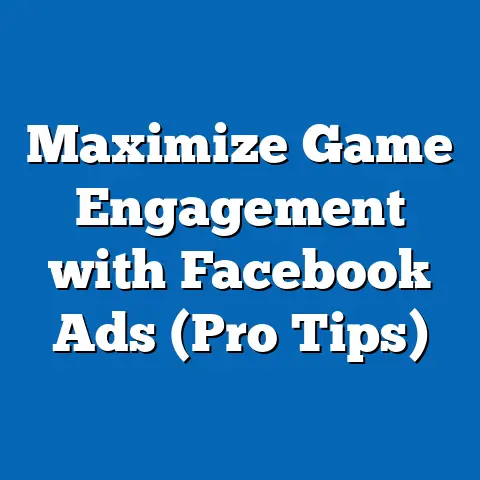Fixing Facebook Ads Targeting Glitch (Expert Solutions)
Fixing Facebook Ads Targeting Glitch: Expert Solutions to Enhance Your Campaign Performance
According to a recent report by eMarketer, approximately 50% of marketers have experienced issues with Facebook Ads targeting, leading to wasted budget and ineffective campaigns. This is a problem that many of us face, and understanding how to navigate these challenges is crucial for success on the platform.
Understanding Facebook Ads Targeting
Facebook Ads targeting is the backbone of any successful campaign. It’s how we ensure our ads are seen by the right people, increasing the likelihood of engagement and conversions. Think of it as aiming a dart – the more precise your aim, the better your chances of hitting the bullseye.
-
What is Facebook Ads Targeting? At its core, Facebook Ads targeting involves selecting specific criteria to define who sees your ads. This can range from broad demographics to highly specific interests and behaviors.
-
Why is it Important? Effective targeting means your ads are more relevant to your audience. This leads to higher engagement rates, lower ad costs, and ultimately, a better return on your investment. Imagine showing a vegan recipe to a meat lover – chances are, they won’t be interested. The same principle applies to your ads.
-
Types of Targeting Options:
- Demographic Targeting: This includes age, gender, location, education, job title, and more. It’s the foundation of your targeting strategy.
- Interest Targeting: This allows you to target people based on their interests, hobbies, and the pages they like on Facebook.
- Behavioral Targeting: This targets users based on their online behavior, such as purchase history, device usage, and travel habits.
- Custom Audiences: These are audiences you create from your own data, such as email lists, website visitors, or app users.
- Lookalike Audiences: These are audiences that Facebook creates based on your Custom Audiences, targeting people who share similar characteristics and behaviors.
What is Facebook Ads Targeting? At its core, Facebook Ads targeting involves selecting specific criteria to define who sees your ads. This can range from broad demographics to highly specific interests and behaviors.
Why is it Important? Effective targeting means your ads are more relevant to your audience. This leads to higher engagement rates, lower ad costs, and ultimately, a better return on your investment. Imagine showing a vegan recipe to a meat lover – chances are, they won’t be interested. The same principle applies to your ads.
Types of Targeting Options:
- Demographic Targeting: This includes age, gender, location, education, job title, and more. It’s the foundation of your targeting strategy.
- Interest Targeting: This allows you to target people based on their interests, hobbies, and the pages they like on Facebook.
- Behavioral Targeting: This targets users based on their online behavior, such as purchase history, device usage, and travel habits.
- Custom Audiences: These are audiences you create from your own data, such as email lists, website visitors, or app users.
- Lookalike Audiences: These are audiences that Facebook creates based on your Custom Audiences, targeting people who share similar characteristics and behaviors.
My Experience: I remember one campaign where I was targeting small business owners. I initially used broad demographic targeting, but the results were mediocre. Once I refined my audience to include specific interests like “entrepreneurship,” “small business marketing,” and “digital marketing,” I saw a significant improvement in engagement and conversions.
Key Takeaway: Facebook Ads targeting is a powerful tool when used correctly. Understanding the different options and how they can be combined is essential for creating effective campaigns.
Common Targeting Glitches
Even with a solid understanding of targeting options, glitches can still occur. Here are some common issues I’ve encountered and how to identify them:
-
Audience Overlap and Audience Fatigue:
- What it is: Audience overlap occurs when multiple ad sets target the same people. Audience fatigue happens when your audience sees your ads too frequently, leading to decreased engagement.
- Why it happens: Overlap can occur when you have multiple campaigns running with similar targeting criteria. Fatigue happens when your audience size is too small, or your ad frequency is too high.
- How to identify: Facebook’s Audience Overlap tool allows you to see how much your audiences overlap. Monitor your ad frequency and engagement metrics to identify fatigue.
-
Inaccurate Audience Insights or Data Discrepancies:
- What it is: Sometimes, the data provided by Facebook’s Audience Insights tool doesn’t align with your actual campaign results.
- Why it happens: Data discrepancies can occur due to various factors, including sampling errors, algorithm updates, and user privacy settings.
- How to identify: Compare your campaign performance data with the insights provided by the Audience Insights tool. If there are significant discrepancies, it’s a sign that something is off.
-
Issues with Custom Audiences and Lookalike Audiences:
- What it is: Custom Audiences may not match the expected size or performance, and Lookalike Audiences may not deliver the desired results.
- Why it happens: This can happen due to outdated data, changes in user behavior, or issues with the data source.
- How to identify: Regularly check the size and match rate of your Custom Audiences. Monitor the performance of your Lookalike Audiences and compare them to your source audience.
-
Targeting Restrictions Due to User Privacy Settings:
- What it is: Changes in user privacy settings and data policies can limit your ability to target specific demographics or behaviors.
- Why it happens: Facebook is constantly updating its privacy policies to comply with regulations like GDPR and CCPA.
- How to identify: Stay informed about Facebook’s privacy updates and adjust your targeting strategies accordingly. Monitor your ad delivery and reach to see if there are any unexpected drops.
Audience Overlap and Audience Fatigue:
- What it is: Audience overlap occurs when multiple ad sets target the same people. Audience fatigue happens when your audience sees your ads too frequently, leading to decreased engagement.
- Why it happens: Overlap can occur when you have multiple campaigns running with similar targeting criteria. Fatigue happens when your audience size is too small, or your ad frequency is too high.
- How to identify: Facebook’s Audience Overlap tool allows you to see how much your audiences overlap. Monitor your ad frequency and engagement metrics to identify fatigue.
Inaccurate Audience Insights or Data Discrepancies:
- What it is: Sometimes, the data provided by Facebook’s Audience Insights tool doesn’t align with your actual campaign results.
- Why it happens: Data discrepancies can occur due to various factors, including sampling errors, algorithm updates, and user privacy settings.
- How to identify: Compare your campaign performance data with the insights provided by the Audience Insights tool. If there are significant discrepancies, it’s a sign that something is off.
Issues with Custom Audiences and Lookalike Audiences:
- What it is: Custom Audiences may not match the expected size or performance, and Lookalike Audiences may not deliver the desired results.
- Why it happens: This can happen due to outdated data, changes in user behavior, or issues with the data source.
- How to identify: Regularly check the size and match rate of your Custom Audiences. Monitor the performance of your Lookalike Audiences and compare them to your source audience.
Targeting Restrictions Due to User Privacy Settings:
- What it is: Changes in user privacy settings and data policies can limit your ability to target specific demographics or behaviors.
- Why it happens: Facebook is constantly updating its privacy policies to comply with regulations like GDPR and CCPA.
- How to identify: Stay informed about Facebook’s privacy updates and adjust your targeting strategies accordingly. Monitor your ad delivery and reach to see if there are any unexpected drops.
My Experience: I once had a Custom Audience that suddenly stopped performing well. After investigating, I discovered that the email list I was using was outdated and contained many inactive accounts. Updating the list with fresh data significantly improved the audience’s performance.
Key Takeaway: Identifying targeting glitches requires careful monitoring and analysis. Regularly check your audience data, campaign performance, and Facebook’s privacy updates to stay ahead of potential issues.
Impact of Targeting Glitches on Campaign Performance
Targeting glitches can have a significant impact on your campaign performance, leading to wasted budget and missed opportunities. Here’s how these glitches can affect your results:
-
Increased Cost Per Click (CPC) and Cost Per Acquisition (CPA):
- How it happens: When your ads are shown to the wrong audience, your click-through rate (CTR) decreases, and your CPC increases. This, in turn, leads to a higher CPA.
- Why it matters: Higher CPC and CPA mean you’re paying more for each click and conversion, reducing your overall profitability.
-
Decreased Return on Ad Spend (ROAS):
- How it happens: Poor targeting leads to lower conversion rates and higher ad costs, resulting in a lower ROAS.
- Why it matters: ROAS is a critical metric for measuring the effectiveness of your ad campaigns. A low ROAS indicates that you’re not getting enough value from your ad spend.
-
Poor Engagement Rates and Lower Conversion Metrics:
- How it happens: Irrelevant ads lead to lower engagement rates (likes, comments, shares) and fewer conversions (leads, sales).
- Why it matters: Engagement rates are a good indicator of how well your ads resonate with your audience. Low conversion metrics mean you’re not achieving your campaign goals.
Increased Cost Per Click (CPC) and Cost Per Acquisition (CPA):
- How it happens: When your ads are shown to the wrong audience, your click-through rate (CTR) decreases, and your CPC increases. This, in turn, leads to a higher CPA.
- Why it matters: Higher CPC and CPA mean you’re paying more for each click and conversion, reducing your overall profitability.
Decreased Return on Ad Spend (ROAS):
- How it happens: Poor targeting leads to lower conversion rates and higher ad costs, resulting in a lower ROAS.
- Why it matters: ROAS is a critical metric for measuring the effectiveness of your ad campaigns. A low ROAS indicates that you’re not getting enough value from your ad spend.
Poor Engagement Rates and Lower Conversion Metrics:
- How it happens: Irrelevant ads lead to lower engagement rates (likes, comments, shares) and fewer conversions (leads, sales).
- Why it matters: Engagement rates are a good indicator of how well your ads resonate with your audience. Low conversion metrics mean you’re not achieving your campaign goals.
My Experience: I once ran a campaign where the ROAS was consistently low. After analyzing the data, I realized that I was targeting a broad audience with generic ad copy. By refining my targeting and creating more specific ad copy, I was able to significantly improve the ROAS.
Key Takeaway: Targeting glitches can have a cascading effect on your campaign performance. Addressing these issues promptly is crucial for maintaining a healthy ROAS and achieving your advertising goals.
Expert Solutions for Fixing Targeting Glitches
Now, let’s get to the heart of the matter: how to fix these targeting glitches. Here are some expert solutions I’ve used to overcome these challenges:
-
Audience Optimization:
- Refining Your Audience: Use Facebook’s Audience Insights tool to gain a deeper understanding of your target audience. Look for patterns in their demographics, interests, and behaviors.
- A/B Testing Different Audience Segments: Create multiple ad sets targeting different audience segments. Test different combinations of demographics, interests, and behaviors to see which performs best.
- Layering Targeting Options: Combine multiple targeting options to create a more specific audience. For example, target people who are interested in “digital marketing” and have a job title of “marketing manager.”
- Excluding Audiences: Exclude audiences that are not performing well or are not relevant to your campaign. For example, exclude people who have already purchased your product.
-
Data Verification:
- Ensuring Accurate Data: Regularly check the accuracy of the data feeding into your Custom Audiences. Make sure your email lists are up-to-date and your website tracking is working correctly.
- Updating Customer Data: Update your customer data regularly to reflect changes in user behavior and demographics.
- Segmenting Your Data: Segment your customer data based on different criteria, such as purchase history, engagement level, and demographics. This will allow you to create more targeted Custom Audiences.
-
Utilizing Facebook’s Diagnostic Tools:
- Ads Manager: Use the Ads Manager to monitor your campaign performance and identify potential issues. Pay attention to metrics like CPC, CPA, CTR, and ROAS.
- Campaign Performance Insights: Use the Campaign Performance Insights tool to get a deeper understanding of how your campaigns are performing. Look for patterns in your data and identify areas for improvement.
- Audience Overlap Tool: Use the Audience Overlap tool to see how much your audiences overlap and identify potential issues with audience fatigue.
-
Adjusting Targeting Settings:
- Narrowing Your Target: Narrow your target audience by adding more specific criteria. This will help you reach people who are more likely to be interested in your product or service.
- Expanding Your Target: Expand your target audience by removing some of your targeting criteria. This can help you reach a larger audience and increase your potential reach.
- Testing Different Placements: Test different ad placements to see which performs best. Facebook offers a variety of placements, including Facebook Feed, Instagram Feed, Audience Network, and Messenger.
-
Retargeting Strategies:
- Website Retargeting: Retarget people who have visited your website but haven’t made a purchase. Show them ads for the products they viewed or offer them a discount.
- Engagement Retargeting: Retarget people who have engaged with your Facebook page or Instagram profile. Show them ads for your products or services or invite them to join your email list.
- Video Retargeting: Retarget people who have watched your videos on Facebook or Instagram. Show them ads that are relevant to the content of the videos they watched.
- Dynamic Product Ads: Use Dynamic Product Ads to retarget people who have viewed products on your website. Show them ads for the specific products they viewed or similar products.
Audience Optimization:
- Refining Your Audience: Use Facebook’s Audience Insights tool to gain a deeper understanding of your target audience. Look for patterns in their demographics, interests, and behaviors.
- A/B Testing Different Audience Segments: Create multiple ad sets targeting different audience segments. Test different combinations of demographics, interests, and behaviors to see which performs best.
- Layering Targeting Options: Combine multiple targeting options to create a more specific audience. For example, target people who are interested in “digital marketing” and have a job title of “marketing manager.”
- Excluding Audiences: Exclude audiences that are not performing well or are not relevant to your campaign. For example, exclude people who have already purchased your product.
Data Verification:
- Ensuring Accurate Data: Regularly check the accuracy of the data feeding into your Custom Audiences. Make sure your email lists are up-to-date and your website tracking is working correctly.
- Updating Customer Data: Update your customer data regularly to reflect changes in user behavior and demographics.
- Segmenting Your Data: Segment your customer data based on different criteria, such as purchase history, engagement level, and demographics. This will allow you to create more targeted Custom Audiences.
Utilizing Facebook’s Diagnostic Tools:
- Ads Manager: Use the Ads Manager to monitor your campaign performance and identify potential issues. Pay attention to metrics like CPC, CPA, CTR, and ROAS.
- Campaign Performance Insights: Use the Campaign Performance Insights tool to get a deeper understanding of how your campaigns are performing. Look for patterns in your data and identify areas for improvement.
- Audience Overlap Tool: Use the Audience Overlap tool to see how much your audiences overlap and identify potential issues with audience fatigue.
Adjusting Targeting Settings:
- Narrowing Your Target: Narrow your target audience by adding more specific criteria. This will help you reach people who are more likely to be interested in your product or service.
- Expanding Your Target: Expand your target audience by removing some of your targeting criteria. This can help you reach a larger audience and increase your potential reach.
- Testing Different Placements: Test different ad placements to see which performs best. Facebook offers a variety of placements, including Facebook Feed, Instagram Feed, Audience Network, and Messenger.
Retargeting Strategies:
- Website Retargeting: Retarget people who have visited your website but haven’t made a purchase. Show them ads for the products they viewed or offer them a discount.
- Engagement Retargeting: Retarget people who have engaged with your Facebook page or Instagram profile. Show them ads for your products or services or invite them to join your email list.
- Video Retargeting: Retarget people who have watched your videos on Facebook or Instagram. Show them ads that are relevant to the content of the videos they watched.
- Dynamic Product Ads: Use Dynamic Product Ads to retarget people who have viewed products on your website. Show them ads for the specific products they viewed or similar products.
My Experience: I once had a client who was struggling to generate leads from their Facebook Ads. After analyzing their campaign, I realized that they were not using retargeting. By implementing a retargeting campaign targeting website visitors, I was able to significantly increase their lead generation.
Key Takeaway: Fixing targeting glitches requires a combination of data analysis, experimentation, and strategic adjustments. By implementing these expert solutions, you can improve your campaign performance and achieve your advertising goals.
Case Studies and Examples
Let’s look at some real-world examples of businesses that successfully fixed their targeting glitches and saw a positive impact on their campaign performance:
-
Case Study 1: E-commerce Business
- Problem: An e-commerce business was experiencing low ROAS and high CPA.
- Solution: They used Facebook’s Audience Insights tool to identify their target audience’s interests and behaviors. They then refined their targeting to focus on these specific interests and behaviors. They also implemented a retargeting campaign targeting website visitors who had abandoned their carts.
- Results: They saw a 50% increase in ROAS and a 30% decrease in CPA.
-
Case Study 2: Local Restaurant
- Problem: A local restaurant was struggling to attract new customers through Facebook Ads.
- Solution: They created a Custom Audience based on their email list and a Lookalike Audience based on that Custom Audience. They then targeted these audiences with ads promoting their daily specials and events.
- Results: They saw a 40% increase in foot traffic and a 25% increase in sales.
-
Case Study 3: SaaS Company
- Problem: A SaaS company was experiencing low engagement rates and high ad costs.
- Solution: They A/B tested different ad copy and visuals to see which resonated best with their target audience. They also adjusted their targeting settings to narrow their target audience and exclude irrelevant demographics.
- Results: They saw a 60% increase in engagement rates and a 40% decrease in ad costs.
Case Study 1: E-commerce Business
- Problem: An e-commerce business was experiencing low ROAS and high CPA.
- Solution: They used Facebook’s Audience Insights tool to identify their target audience’s interests and behaviors. They then refined their targeting to focus on these specific interests and behaviors. They also implemented a retargeting campaign targeting website visitors who had abandoned their carts.
- Results: They saw a 50% increase in ROAS and a 30% decrease in CPA.
Case Study 2: Local Restaurant
- Problem: A local restaurant was struggling to attract new customers through Facebook Ads.
- Solution: They created a Custom Audience based on their email list and a Lookalike Audience based on that Custom Audience. They then targeted these audiences with ads promoting their daily specials and events.
- Results: They saw a 40% increase in foot traffic and a 25% increase in sales.
Case Study 3: SaaS Company
- Problem: A SaaS company was experiencing low engagement rates and high ad costs.
- Solution: They A/B tested different ad copy and visuals to see which resonated best with their target audience. They also adjusted their targeting settings to narrow their target audience and exclude irrelevant demographics.
- Results: They saw a 60% increase in engagement rates and a 40% decrease in ad costs.
My Experience: I worked with a client who was launching a new product. They were initially targeting a broad audience with generic ad copy. By creating more specific ad copy and targeting it to different audience segments based on their interests and behaviors, we were able to achieve a much higher conversion rate.
Key Takeaway: These case studies demonstrate the power of addressing targeting glitches and implementing effective solutions. By analyzing your data, experimenting with different strategies, and staying informed about Facebook’s updates, you can achieve significant improvements in your campaign performance.
Future-Proofing Your Facebook Ads Targeting
To minimize future targeting glitches, it’s essential to take proactive measures and stay informed about changes in the Facebook advertising landscape:
-
Keeping Abreast of Facebook’s Algorithm Changes and Updates:
- Follow Facebook’s Official Blog: Stay up-to-date with the latest news and updates from Facebook’s official blog.
- Attend Webinars and Conferences: Attend webinars and conferences focused on Facebook advertising to learn about new features and best practices.
- Join Online Communities: Join online communities and forums where marketers share their experiences and insights about Facebook advertising.
-
Regularly Reviewing and Adjusting Targeting Strategies:
- Monitor Your Campaign Performance: Regularly monitor your campaign performance and identify potential issues.
- Analyze Your Data: Analyze your data to identify patterns and trends.
- Adjust Your Targeting Settings: Adjust your targeting settings based on your data and insights.
-
Engaging in Continuous Learning:
- Take Online Courses: Take online courses focused on Facebook advertising to expand your knowledge and skills.
- Read Industry Publications: Read industry publications and blogs to stay informed about the latest trends and best practices.
- Experiment with New Features: Experiment with new features and tools offered by Facebook to see how they can improve your campaign performance.
Keeping Abreast of Facebook’s Algorithm Changes and Updates:
- Follow Facebook’s Official Blog: Stay up-to-date with the latest news and updates from Facebook’s official blog.
- Attend Webinars and Conferences: Attend webinars and conferences focused on Facebook advertising to learn about new features and best practices.
- Join Online Communities: Join online communities and forums where marketers share their experiences and insights about Facebook advertising.
Regularly Reviewing and Adjusting Targeting Strategies:
- Monitor Your Campaign Performance: Regularly monitor your campaign performance and identify potential issues.
- Analyze Your Data: Analyze your data to identify patterns and trends.
- Adjust Your Targeting Settings: Adjust your targeting settings based on your data and insights.
Engaging in Continuous Learning:
- Take Online Courses: Take online courses focused on Facebook advertising to expand your knowledge and skills.
- Read Industry Publications: Read industry publications and blogs to stay informed about the latest trends and best practices.
- Experiment with New Features: Experiment with new features and tools offered by Facebook to see how they can improve your campaign performance.
My Experience: I’ve found that staying active in online communities and attending industry events has been invaluable for keeping up with the latest trends and best practices in Facebook advertising.
Key Takeaway: Future-proofing your Facebook Ads targeting requires a commitment to continuous learning and adaptation. By staying informed about Facebook’s updates, regularly reviewing your targeting strategies, and engaging in continuous learning, you can minimize future targeting glitches and maintain a competitive edge.
Conclusion
Fixing Facebook Ads targeting glitches is crucial for optimizing campaign performance and achieving your advertising goals. By understanding the different targeting options, identifying common glitches, implementing expert solutions, and staying informed about Facebook’s updates, you can maximize your advertising effectiveness on the platform. Remember, Facebook advertising is an ever-evolving landscape, and continuous learning and adaptation are essential for success.
Call to Action
Now, I’d love to hear from you! What targeting glitches have you encountered in your Facebook Ads campaigns, and what solutions have you found to be effective? Share your experiences in the comments below, and let’s learn from each other and build a stronger community of Facebook advertisers!






